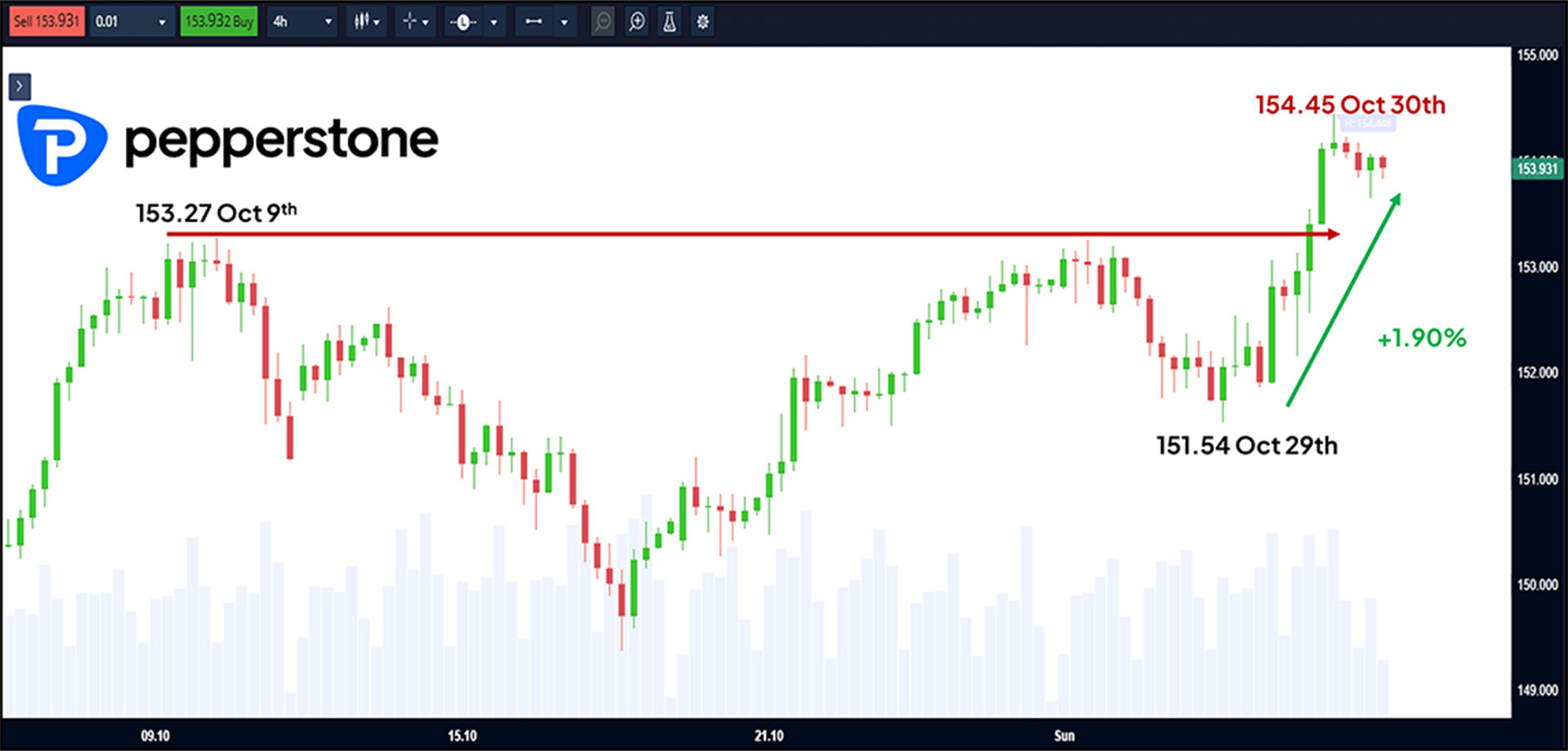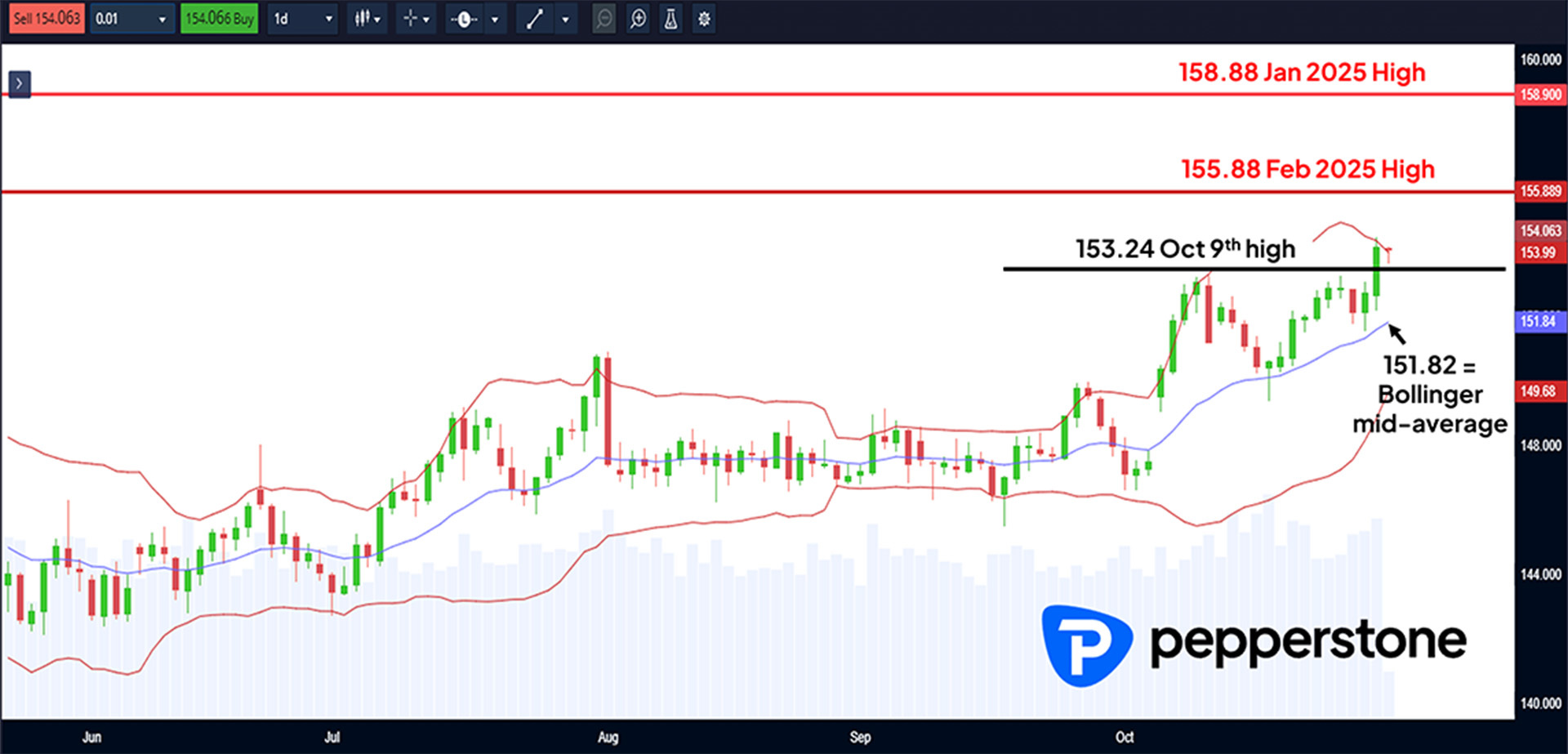Spread bets and CFDs are complex instruments and come with a high risk of losing money rapidly due to leverage. 72% of retail investor accounts lose money when trading spread bets and CFDs with this provider. You should consider whether you understand how spread bets and CFDs work, and whether you can afford to take the high risk of losing your money.
- English (UK)

Summary
- Sharp Acceleration: From Wednesday’s low, USDJPY has rallied 1.90%, in the process breaking above the 153.27 high resistance.
- Catalysts: A combination of a hawkish US Federal Reverse Bank (Fed) and a dovish BoJ brought interest rate differentials to the forefront of trader’s minds, resulting in USD outperformance.
- Drivers: Further indications of interest rates moves out of both Japan and the US and if current USDJPY upside momentum in price continues following breaks above 153.27.
Why is USDJPY rallying?
USDJPY surged 1.90% from Wednesday’s low to Thursday’s high, powered by two central bank decisions. Hawkish tones from the Fed and a dovish hold from the BoJ boosted the dollar, sending the pair through important resistance levels.

The higher acceleration in USDJPY on Thursday was fuelled by the Bank of Japan’s decision to leave rates unchanged and offer no clear signal of imminent hikes, disappointing traders hoping for a hawkish shift and triggering yen selling.
Combined with a strengthening U.S. dollar following Wednesday’s Fed meeting, the BoJ’s dovish stance on Thursday amplified USDJPY buying momentum, driving the pair sharply higher as traders digested the widening policy and yield divergence.
Firm U.S. Treasury yields can continue to support USDJPY upside, as the dollar remains more attractive to traders compared to the low-yielding yen. This widening rate differential might continue to see demand for dollar-denominated assets.
What could influence USDJPY from here?
USDJPY’s near-term outlook could hinge on any fresh signals from both the Fed and the BoJ. With rate divergence still front and centre, any shift in expectations, hawkish or dovish, could tip the balance. Traders will be watching closely for clues on the path ahead, as the perceived gap between U.S. and Japanese interest rates remains a key driver of momentum.
Any comments seen from chairman Powell over coming days, will see markets focused on his tone for any hints on future direction of US rates. If he sounds hawkish, further reducing possibilities of US interest rate cuts, it could reinforce dollar strength and push the USDJPY higher.
On the flip side, a dovish tilt might shift sentiment, softening the dollar and potentially reviving yen demand as traders reassess the Fed’s policy path.
It’s also worth remembering that the Bank of Japan has a history of stepping in to curb USDJPY strength, using FX intervention to buy yen and push the pair lower. If upside momentum continues and USDJPY strength stretches further, speculation around potential intervention could resurface. Traders may then start pricing in the risk, or at least the rhetoric, of official action.
Where next for USDJPY?

As shown in the daily chart above, USDJPY found support at the rising Bollinger mid-average (currently at 151.82) sparking the latest upside momentum. The rally was fuelled by the Fed’s steady stance and the BoJ’s dovish hold combining to drive the pair higher.
Thursday’s price action saw USDJPY break decisively above the October 9th high of 153.24, pushing the pair to levels last seen in February 2025. This breakout acted as a catalyst for strength as traders viewed this move as signs of trend continuation.
To the upside, initial resistance may emerge at 155.88, the February 2025 monthly high. A break above 155.86 could open the door to a test of 158.88, marking the year-to-date peak, posted back in January, and perhaps a key psychological barrier for USDJPY bulls. Future price momentum will be crucial in determining whether these levels hold or give way.
In terms of support, traders focus may now be on to 153.00, which is half this week’s current range, and if this gives way onto the rising Bollinger mid-average currently at 151.82.
Support: 153.00 (half this week’s range),151.82 (Bollinger mid-average), 151.33 (61.8% Fibonacci retracement)
Resistance: 154.45 (Thursday’s session high), 155.88 (February 2025 high), 158.88 (January 2025 high).
The material provided here has not been prepared in accordance with legal requirements designed to promote the independence of investment research and as such is considered to be a marketing communication. Whilst it is not subject to any prohibition on dealing ahead of the dissemination of investment research we will not seek to take any advantage before providing it to our clients.
Pepperstone doesn’t represent that the material provided here is accurate, current or complete, and therefore shouldn’t be relied upon as such. The information, whether from a third party or not, isn’t to be considered as a recommendation; or an offer to buy or sell; or the solicitation of an offer to buy or sell any security, financial product or instrument; or to participate in any particular trading strategy. It does not take into account readers’ financial situation or investment objectives. We advise any readers of this content to seek their own advice. Without the approval of Pepperstone, reproduction or redistribution of this information isn’t permitted.
